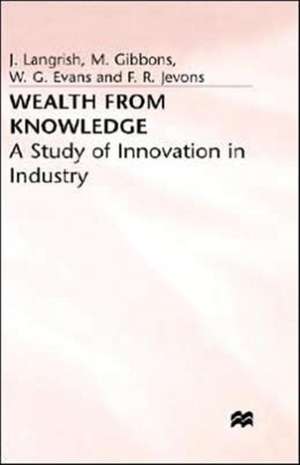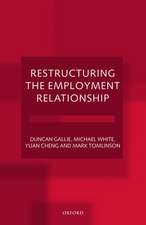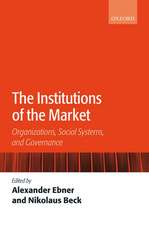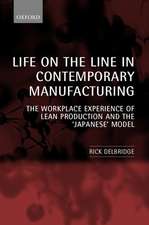Wealth from Knowledge: Studies of Innovation in Industry
Autor J. Langrish, M. Gibbons, W.G. Evans, F.R. Jevonsen Limba Engleză Hardback – 19 ian 1972
| Toate formatele și edițiile | Preț | Express |
|---|---|---|
| Paperback (1) | 647.59 lei 6-8 săpt. | |
| Palgrave Macmillan UK – 1972 | 647.59 lei 6-8 săpt. | |
| Hardback (1) | 653.33 lei 6-8 săpt. | |
| Palgrave Macmillan UK – 19 ian 1972 | 653.33 lei 6-8 săpt. |
Preț: 653.33 lei
Preț vechi: 768.62 lei
-15% Nou
Puncte Express: 980
Preț estimativ în valută:
125.01€ • 130.88$ • 103.44£
125.01€ • 130.88$ • 103.44£
Carte tipărită la comandă
Livrare economică 05-19 aprilie
Preluare comenzi: 021 569.72.76
Specificații
ISBN-13: 9780333120071
ISBN-10: 0333120078
Pagini: 477
Ilustrații: XIII, 477 p.
Dimensiuni: 140 x 216 x 32 mm
Greutate: 0.78 kg
Ediția:1972
Editura: Palgrave Macmillan UK
Colecția Palgrave Macmillan
Locul publicării:London, United Kingdom
ISBN-10: 0333120078
Pagini: 477
Ilustrații: XIII, 477 p.
Dimensiuni: 140 x 216 x 32 mm
Greutate: 0.78 kg
Ediția:1972
Editura: Palgrave Macmillan UK
Colecția Palgrave Macmillan
Locul publicării:London, United Kingdom
Cuprins
Preface PART ONE: GENERAL DISCUSSION Wealth from knowledge Uncertainty Our investigation Sources of technological innovation Multiple sources Roles of individuals in innovation Independent inventors The institutional environment Managers and creative researchers The question of research group size Demarcation difficulties Variations over time Time-Sharing The myth of discreteness Interactions between different organisations University research Government research Government finance Licensing between firms Role of customers Overlap of objectives Roles of science in innovation The Byatt-Cohen method tested Routes for economic benefits from science Justifications for basic science Technology transfer Development of technology Models of technology transfer Practical considerations Relations of research to marketing Market-oriented R&D Reservations about market orientation References for Part One PART TWO: SOME QUANTITATIVE RESULTS The Queen's Award scheme What kinds of innovations? Factorsenabling Award-winning firms to succeed Factors causing delay in innovation Linear models of innovation Sources of ideas Sizes of firms Methodology List of innovations References for Part Two PART THREE: CASE STUDIES Automotive Products Ltd: Automatic Transmission System Beecham Group: New Antibiotics Bonas Bros Weavematic Looms: Shuttleless Looms British Baking Industries Research Association: Chorleywood Bread Process British Insulated Callender's Cables: Continuously Transposed Cables David Brown Corporation (Vosper Thornycroft): Gas-Turbine-Powered Fast Patrol Boats Cambridge Scientific Instruments: Stereoscan Electron Microscope Colchester Lathe Co.: Methods of Lathe Manufacture Concrete Ltd: Industrialised Building Davy-Ashmore: Automatic Control of Steel Strip Thickness English Electric: Brushless Generators for Aircraft English Electric: Fuses for Semiconductor Devices English Electric/Marconi: The Mark VII Colour Television Camera Ethicon Ltd and H.S.Marsh Ltd: Sterilisationby Irradiation Ferranti: Lightweight Inertial Platforms Ferranti: Numerical Control Equipment Ferranti: Monolithic Microcircuits Ferranti: Electronic Summation Metering Freeman Fox and Partners: Severn Bridge Design General Electric Co.: Semiconductored Radio Equipment Hawker Siddeley Group (Mirrlees National): Large Diesel Engines on Medium Speed Imperial Chemical Industries : Procion Reactive Dyes J. and S.Pumps Ltd: Sealed Motor Pump Units and Turbine Alternator Units Linen Industry Research Association, and McCleery and L'Amie Ltd: The ATOZ Process Joseph Lucas (Electrical) Ltd: High-Voltage Transistors Lytag Ltd: Lightweigh Aggregate from Pulversied Fuel Ash Martin-Baker Aircraft Co.: Aircraft Ejector Seats Metals Research: Image-Analysing Computer Oxford Instrument Co.: High Magnetic Fields and Low Temperatures Plasticisers Ltd: Synthetic Material for Cordage Renold Group (J.Holroyd): Rotor Milling Machines Sanders and Forster: Structural Steelwork Short Brothers and Harland: Seacat Guided Weapon System Smiths Industries: Aircraft Automatic Landing Equipment Smiths Industries (Kelvin Hughes): Radar Navigational Aid Thorium Ltd: Rare Earth Separation Index
Notă biografică
J.LANGRISH is Professor of Design Research, Salford University. He was Dean of the Institute of Advanced Studies, Manchester Metropolitan University and wass Senior Research Fellow, Manchester Business School.
M. GIBBONS is a Lecturer at the Department of Liberal Studies in Science, University of Manchester
W.G. EVANS is a Lecturer at the Department of Liberal Studies in Science, University of Manchester
F.R. JEVONS is Professor and Head of the Department of Liberal Studies in Science, University of Manchester.
M. GIBBONS is a Lecturer at the Department of Liberal Studies in Science, University of Manchester
W.G. EVANS is a Lecturer at the Department of Liberal Studies in Science, University of Manchester
F.R. JEVONS is Professor and Head of the Department of Liberal Studies in Science, University of Manchester.
















